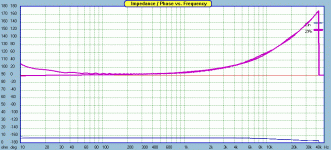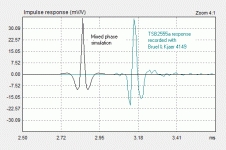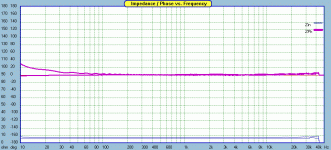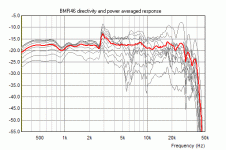Earl,
What kind of benefits you expect from your phase plug with optimum apertures? As you see 12" OSWG performs pretty well - phase plug has constant slits and distance to throat is 25mm. Do you think new phase plug will enable a better control over directivity or?
Any HOM that are present at the throat of a waveguide will propagate to the mouth and radiate (unless they are absorbed through the use of foam). Hence, IF minimum HOM are the goal, then minimizing the HOM being created by the phase plug becomes important. The "optimum aperature" patent does that.
Basically, you cannot extract T/S parameters with these kinds of drivers.
Thats not true. It may not be as easy, but its always doable. There are techniques (see my book) that can extract TS parameters without touching the device at all.
http://www.diyaudio.com/forums/multi-way/103872-geddes-waveguides-241.html#post1775647The level of expertise is quite different, so its not quite the same thing.
George, I not only never said that, but the opposite is true. (Half of what I am claimed to say and believe here is simply not the case.) I prefer the term "Controlled Directivity", but as stated here often, none of these terms are solidly defined.
For which driver have you done that on? Something like these two?Thats not true. It may not be as easy, but its always doable. There are techniques (see my book) that can extract TS parameters without touching the device at all.
Attachments
For which driver have you done that on? Something like these two?
How do you get phase increaseing at high frequency while the impedance amlitude drops?????
You know, those were tested on using sound cards that need pulse delay of -0.01041ms applied, and I forgot to do it. Thanks for catching that. I had proposed a long time ago to have the necessary delay applied in the "preferences" and compensated for when generating the impulse response so that the impulse files will read the same whenever you read back the saved files regadless which system the data was generated on, but that request was probably forgotten.How do you get phase increaseing at high frequency while the impedance amlitude drops?????
Here is the corrected ones.
Attachments
I objected to how you defined "Controlled Directivity" to be "which means that you control the directivity to the extent you see fit" not the use of the term itself. I have no objection to the term if its meaning is more constrained than "whatever I want".
For which driver have you done that on? Something like these two?
Because you have insufficient data does not mean that "it cannot be done".
And that was because there was no clear definition of "Contant Directivity", which has not changed to date.I objected to how you defined "Controlled Directivity" to be "which means that you control the directivity to the extent you see fit" not the use of the term itself. I have no objection to the term if its meaning is more constrained than "whatever I want".
I was just wondering, because about a year ago, someone wanted to do it on micro speakers to derive some performance data during their MS studies. I did not even think it worthwhile trying because even if done, the data would not be usefull for design work.
I have a patent applcation that describes how to calculate all of the pertinent TS data without the need to contact the driver or perturb it in any way. It requires two measurements; one of voltage to pressure and then current to pressure. The rest is just math. This data is always useful - it doesn't mean anything less for small speakers than for larger ones.
The data that you showed is not sufficient to calculate anything from and it doesn't even look like transducer data at all.
Quite interestingly, I ran across a coniguration that gave pretty good directivity probably slightly better than the last posted configuration I made, but with only a 3db slope. Same driver model I've been using....
So, if someone states that its not possible that we can have constant directivity (in the words technical meaning) *without* a 6dB slope – which is the case here – I hold against my measurements :
...
Michael
Well, that is impedance of a tweeter.
Anyway, It was quite interesting to find how much the throat design can effect acoustic impedance. I'm beginning to suspect there is an equation for fitting a shape to an acoustic impedance/frequency.
What you showed was the impedance?
There is a "relationship" even if there isn't a simple equation.
Yes, impedance.
The impedance alone is insufficient to tell much. You always need some measure of the transfer of the electrical domain to the mechanical/acoustical domain.
It's possible to use lazer, but now since the diaphragm is vibrating like flexible paper, what meaningful data would that bring since force is distrubuted, mass is ununiformly distrubuted, etc. Give us some news if someone really has measured T/S parameters for a driver like MANGER, and really used those T/S parameters in design work. Let's not forget the original purpose for which the parameters were generated for.
I'm hardly any expert on Manger - but all I know of is that you simply can't compare its working principle to a magnetostat nor an AMT - rather to a Walsh IMO - this means - Manger is *intentionally* not a piston source.
Magnetostat and AMT are piston sources - if one can say such from a diaphragm clamped at the sourround - but at least from the (more or less) flat wave front they generate.
Therefor I was amazed to hear that a manger can be used on a horn - as it seems -even with exciting results. But thats definitely a different story to magnetostat or AMT on horn
Michael
Magnetostat and AMT are piston sources - if one can say such from a diaphragm clamped at the sourround - but at least from the (more or less) flat wave front they generate.
Therefor I was amazed to hear that a manger can be used on a horn - as it seems -even with exciting results. But thats definitely a different story to magnetostat or AMT on horn
Michael
Last edited:
- Home
- Loudspeakers
- Multi-Way
- Geddes on Waveguides



